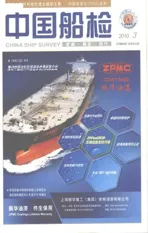加快制定内河船用柴油机排放控制标准
2010-05-26
本刊记者 徐 华
加快制定内河船用柴油机排放控制标准
本刊记者 徐 华

金东寒
中国工程院院士,中国热气机专业第一位博士,国际热气机会议唯一的一位中国理事。长期致力于我国新型动力研究工作,是我国热气机技术领域具有国际影响力的代表性人物,享受国务院特殊津贴。
2009年12月,张德江副总理在到长江专题调研考察内河航运情况时强调,要把内河航运发展摆在重要位置,加快发展畅通高效平安绿色内河航运。今年“两会”期间,加快内河航运发展,更是成为代表委员热议的话题。作为中国热气机专业的第一位博士,金东寒委员敏锐地把关注的目光投向了内河船用柴油机排放控制标准。
记 者:在加快发展畅通高效平安绿色内河航运的背景下,内河船用柴油机的排放问题也受到越来越多关注。其尾气排放中主要有哪些污染物?
金东寒:柴油机是内河船舶的最主要动力源,其排出的尾气中含有大量的有毒物和致癌物。美国国家环保局将柴油机排气中的40余种化合物列为危险空气污染物。这些污染物绝大多数吸附于排气中的颗粒(直径2.5微米以下)中,长期漂浮于空气之中,影响港口及城市的大气质量。
国内外的研究表明,除吸附有害化合物的颗粒(PM)外,柴油机排放中对人体和环境最有影响的还有CO(一氧化碳)、HC(碳氢化合物)、NOx(氮氧化物)和SOx(氧化硫)。其中HC、NOx和颗粒在影响空气质量的同时,对人体心脏和呼吸系统产生致命影响。它们是心血管和呼吸系统疾病的主要原因,是重要的致癌物,短时接触就可以引起流泪、喉咙和支气管发痒、咳嗽、多痰、头晕、恶心,过敏性反应加剧;较长时间接触将引起肺组织病变,呼吸防御机能下降,最终导致肺癌。美国科学家通过对老鼠和猴子的动物实验得出,空气中柴油机有害排放物每增加10微克/立方米,就可以使癌症发病率提高1%。而SOx可随雨水回到地面,形成酸雨,对人体健康、生态系统和建筑设施都有直接和潜在的危害。
记 者:我国内河船舶尾气排放污染状况是否严重?
金东寒:我国是内河航运资源比较丰富的国家之一,拥有大、小天然河流5800多条,河流总长43万公里,其中流域面积在1000平方公里以上的河流有80多条,还有天然湖泊900多个,目前通航里程超过12万公里,随着航道整治工作的开展、西部大开发和振兴东北规划的落实,通航里程还将进一步提升。
我国现有内河船舶约20万艘,2000多万载重吨,其中小型船舶20余万艘,中型以上近2万艘,每年排放的NOx、SOx和颗粒约为100万吨,已超过全国所有公路运营汽车排放总量的一半以上。上海市环境监测中心提供的上海港2005年排放数据显示,NOx排放4.4万吨,SOx排放3.9万吨,颗粒排放0.6万吨。
记 者:内河船舶尾气排放对沿江沿河城市空气质量造成的危害有多大?
金东寒:我国内河运输船舶约有70%集中在长江沿线,分布于上海、南京、武汉和重庆等几个大港,其余分布于黑龙江和珠江流域等。由于船舶在停靠码头、转向和过船闸时,柴油机处于低负荷和变负荷运行,将比正常运行排出更多的有害物。据国家环保局统计,上述长江沿线各个港口城市NOx浓度在0.05到0.15毫克/立方米之间,SOx浓度在0.04到0.10毫克/立方米之间,导致这些城市的中心城区大气环境指标接近或低于国家规定的大气质量二级标准,部分城区甚至低于三级标准。其中,船舶柴油机排出的NOx和SOx占中心城区总量的5%到7%,占港口区域总量的50%。
记 者:我国内河船舶柴油机减排面临怎样的挑战?
金东寒:我国内河船舶用的柴油机都是国产低端产品,大都是在上世纪八十年代开发的,也有部分是在本世纪初开发的。由于我国一直没有排放限制法规,这些产品在研发和制造过程中,为降低成本普遍未采用专门的减少排放的技术措施。因此,与欧美同类船舶柴油机相比,我国内河船舶柴油机有害物排放水平要高出一大截。以NOx排放为例,我国长江沿线船舶应用最广的210系列柴油机排放值为11.97g/kWh,比欧盟相应的排放限制值8.7g/kWh高出37%以上。
记 者:对于内河船舶柴油机的管理,您有哪些建议?
金东寒:在我国移动污染源中,内河船舶还没有专门的国家级排放限制法规,导致内河船舶柴油机的排放处于失控状态,使得内河港口及城市的空气质量每况愈下,制定内河船用柴油机排放控制标准势在必行。目前,国内很多船用柴油机生产企业通过引进和消化国外技术,已经批量生产出系列化的低排放船用柴油机,产品广泛应用于沿海运输船舶并出口国外。因此,制定内河船舶柴油机排放控制标准的条件已经成熟。这不仅有助于保护沿江大气环境,而且还可促进新技术的应用和内河船舶柴油机产品的升级换代,持续提升我国船用柴油机的技术水平。因此,建议行业管理部门尽快着手制定我国内河船舶柴油机排放控制标准。
记 者:对于内河船舶柴油机排放控制标准,国外有哪些成形的标准可以借鉴?
金东寒: 美国和欧盟自上世纪九十年代陆续推出了内河船舶柴油机排放限制标准。以欧盟为例,目前有《商用内河船舶发动机排放控制标准》(2004/26/EC),适用于欧盟境内所有内河;有《莱茵河条例》(CCNR)、《博登湖条例》(BR)和《勃兰登堡航运条例》(BSO),分别适用于特定河流的排放限制法规。这些标准普遍比国际海事组织(IMO)制定的远洋船舶排放控制标准更严格,而且,限制排放的有害物种类更多,例如:除了NOx以外,还包括CO、HC和PM等。主要原因是这些有害物质主要对人体产生伤害,而沿江港口城市又都是人口密集区,因此,从逻辑上讲内河航运的排放标准高于远洋的是合理的。
At the NPC &CPPCC this year, Jin Donghan, the committee member keenly paid attention to the emission control standards of the inland ship diesel engines.
Reporter: Is Chinese inland ship exhaust pollution serious or not?
Jin Donghan:We have inland river ships in service around 200,000, more than 20 million dwt, including more than 20 million small ships, medium-sized or above ships are nearly 20,000, the emission of NOx, SOx and granule reach about 1 million tons every year, which is over half of the total emission at the highway national wide. According to Shanghai environmental monitoring center, the emission data of Shanghai port in 2005 is:NOx 44,000 tons, SOx 39,000 tons, and granule 6000 tons.
Reporter: what is the challenges of China inland marine diesel engine emission reduction?
Jin Donghan: All the diesel engines used in Chinese inland ships are homebred low-end products, most of them are developed in the 1980s, and some are developed at the beginning of the 21Century. Because there is no exhaust restrict laws in our country, in the developing and manufacturing process, in order to reduce the cost, special techniques of emission reduction are not adopted universally. Therefore, our harmful emissions of inland river ships are much more than that of western in terms of the similar diesel engine. Take the NOx emissions as an example, the 210 series diesel engine are widely used in ships along the Yangtze river, its discharge value is 11.97 g/kwh, 37% over corresponding European discharge value of 8.7 g/ kwh.
Reporter: what is your suggestions for the management of inland diesel?
Jin Donghan:At present, many domestic marine diesel engine factories has produced a series of marine diesel engine with lower emissions through introducing foreign technology, and the products are widely applied in coastal vessels and exported abroad. Therefore, the conditions are ready for establishing inland ship diesel emission control standard. It is not only good for protecting the coastal atmospheric environment, but also help to promote the application of new technology and upgrade the diesel engine production, and promote the technology level of our marine diesel engine continuously.
Reporter: For inland ship diesel emission control standards, is there any foreign standards we can used for reference?
Jin Donghan:The United States and the European Union has published inland ship diesel emission limits successively since the 1990s. Take EU as an example,They have “Engine Emission Control Standard of Commercial Inland Ships” (2004 /26/EC), which is applied to all inland rivers within the EU; “the Rhine Regulations”(CCNR), “the Bodensee Regulations” (BR), and “the Brandenburg Shipping Regulations” (BSO), which are applied to some specific rivers. These standards generally more stringent than those for the oceangoing ships emission established by the International Maritime Organization (IMO). In addition, they confine more species of harmful emissions, such as: CO, HC, PM, and etc, besides NOx.
Speed up the Establishment of Inland Marine Diesel Engine Emission Control Standards
Reporter Xu Hua
